 “Chaotic, fickle, enchantress”: Anita Pallenberg Photo: Mangold
“Chaotic, fickle, enchantress”: Anita Pallenberg Photo: Mangold
In 1968, at the height of her beauty, mystery and fame , Anita Pallenberg — model, actress and girlfriend of Keith Richards — starred in the film «Performance». The film, a heady mix of excess and crime, stars Mick Jagger as a washed-up rock star holed up in his crumbling Notting Hill mansion in a ménage-a-trois with his girlfriend Ferber (Pallenberg) and teenage street kid Lucy (Michelle Breton).
Pallenberg, known for playing the evil Black Queen opposite Jane Fonda in Barbarella and for playing the girl who shoots her abusive ex-boyfriend in Volker Schlöndorff's Degree of Murder, later complained that people often confuse she has her roles.
But Ferber, a femme fatale perhaps most vividly expressed in a scene in which she lifts her robe and sticks a hypodermic needle into a shapely buttock, inhaling «too much vitamin B12, never hurt anyone,» felt alarmingly close to Pallenberg. who began using heroin during the filming of the film.
Like Ferber, she was powerful, fickle and often chaotic. “Evil Anita,” as her friend Marianne Faithfull once described her. “The most incredible woman I have ever met in my life. Dazzling, beautiful, hypnotic and disturbing. Other women evaporated around her.»
Yet when she died aged 73 in 2017, her obituaries downplayed this glamorous character, dismissing her as «a true It girl of the 1960s and the muse of the most famous band in the world.»
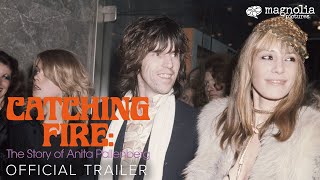
The new documentary Catching Fire: The Anita Pallenberg Story attempts to rectify this situation, tracing the arc of her turbulent life through an incredible selection of home movies from her time with Richards and the Stones, as well as interviews with friends and family, including Richards and by their children Marlon, 54, and Angela, 52.
It's important to note that the documentary is based on Pallenberg's unpublished memoir, narrated by Scarlett Johansson, which Marlon discovered while clearing out her London home a year after her death : 400 «perfectly printed» pages entitled «Black Magic».
“She was obviously playing along with her audience,” Marlon says wryly. The memoir details the darkest periods of her life, from the loss of her infant son to the death of a 17-year-old boy playing Russian roulette in her home in 1979.
“When I read it, I realized she was a much darker person at heart,” says Marlon, speaking from his home in Kent. “When she was alive, she never really went into detail about her old life or how she felt about it, or about her dark thoughts at all. But it was as if she was speaking from the grave, saying exactly what she felt.”
Pallenberg's father was a frustrated artist and Italian travel agent who, Pallenberg once claimed, worked in Berlin as a translator between Mussolini and Hitler before fleeing to Rome, where she was born in 1944. Her mother worked as a secretary at the German embassy.
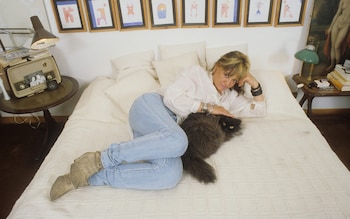 «Too pretty to get out of bed»: Pallenberg originally worked as a model. Photo: Luciano Viti
«Too pretty to get out of bed»: Pallenberg originally worked as a model. Photo: Luciano Viti
A self-described “wild child,” her father sent her to a German boarding school where, at 16, “I expelled myself.” She won a scholarship to study graphic design in Rome, but instead began an affair with avant-garde artist Mario Schifano. In 1963, at age 19, she moved to New York, hanging out at Andy Warhol's factory, cleaning brushes for artist Jasper Johns, and working as a model. Her agency called her «too beautiful to get out of bed.» She was just 21 when a friend took her to a Rolling Stones concert in Munich in 1965, egging her on, as she later recalled, to “kidnap one of the band members.”
Making her way backstage, she singled out Brian Jones, “the most handsome … my double,” and offered him some hashish. “We ended up back in his hotel room,” she later recalled. “And I held him in my arms all night while he cried.”
Within weeks, Jones had evicted his girlfriend and child from his London flat and moved Anita in. She soon abandoned modeling. «We started doing acid and you couldn't do both,» she wrote. «And I loved acid.» Jones was deeply insecure, easily manipulated, and their relationship was always eventful. There were reports of wild sex sessions, sometimes involving the use of whips.
When Stern magazine wanted to photograph Jones for its cover, it was Anita who suggested that he dress in the uniform of a Nazi SS officer and pose while crushing a doll under the heel of his jackboot. The photographs were never used, but caused an uproar in the British press. “It was indecent,” Pallenberg said. “But what the hell? He looked good in the SS uniform.»
 «The most handsome… my double»: Pallenberg and Brian Jones. Photo: J Wilds/Getty Images
«The most handsome… my double»: Pallenberg and Brian Jones. Photo: J Wilds/Getty Images
But as Jones got deeper and deeper into drugs, he became increasingly paranoid, possessive and violent. In 1967, escaping drug busts in London, Jones and Anita traveled to Morocco with Keith Richards. When Jones fell ill en route, Anita and Kate continued on without him. Jones eventually met the couple in Tangier, where he picked up two prostitutes and told Pallenberg to join them. She refused and went out with Richards the next day, leaving Jones behind.
“I fell in love with Anita,” Richards says in Catching Fire. «Her independence, her determination to be free.» The die was cast.
They became a devoted couple, so devoted, as the story goes, that several airlines banned them from obstructing the in-flight toilet. “She definitely made a man out of me,” Richards recalled. They would stay together no matter what for the next 12 years.
Arriving at airports, getting in and out of limousines, they were a postcard pairing of sixties boho and deshabille chic — fur stoles and feather boas, silk scarves, crushed velvet, pirate stripes, Berber bracelets and necklaces. “I was considered the best-dressed man in the world,” Richards succinctly notes in Catching Fire. “I was wearing Anita’s clothes.”
 «I fell in love with Anita»: Pallenberg and Anita immediately after the birth of son Marlon Photo: John Minihan
«I fell in love with Anita»: Pallenberg and Anita immediately after the birth of son Marlon Photo: John Minihan
They were part of a circle that included Donald Cammell, interior designer and esthete Christopher Gibbs, art dealer Robert Fraser and Kenneth Anger, American underground film director, occultist and disciple of Aleister Crowley, who became something of a chief magician in Fraser's gilded circle.
Anita recalled waking up one morning in Redlands, the house she shared with Richards, and looking out the window onto the lawn to see Anger furiously pacing the magic circle. Keith and Anita were said to have considered a pagan wedding ceremony under Anger's direction, but changed their minds.
It was from this milieu that «Performance,» written and directed by Cammell, grew. In both life and film, Pallenberg played a sorceress who taunts and plays with the mind of gangster Chas, played by James Fox, who accidentally wanders into Turner's house, corrupting his tough guy image with magic mushrooms.< /p>
Scenes of Jagger having fun in a Persian-tiled bathroom under sheer sheets inevitably led to a fleeting romance with Jagger during the film's production while Richards waited, fuming at home. But Richards slept with Jagger's girlfriend Marianne Faithfull, so it was even shameful.
None of the actors in Performance escaped unscathed. James Fox joined the evangelical Christian group the Navigators and did not make another film for 10 years. Michelle Breton followed the hippie trail and ended up in a hotel room in Kabul, selling her passport and taking morphine.
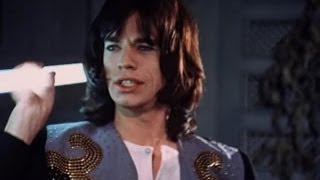
B In 1998 I wrote a book about performance. Pallenberg didn't like giving interviews, but agreed to talk to me. She was a ghost of the beautiful woman she had once been, her face a patchwork of deep wrinkles and cracks worn like war medals. (Pallenberg, her friend Kate Moss says in the documentary, considered cosmetic surgery «useless.»)
She described «Performance» as «the end of the wonderful sixties — love and all that. This film was the end for me.» She was so addicted to drugs, she continued, that she couldn't even remember how the movie came out. “I completely forgot about it.” (In 2006, I gave a talk on «Performance» at a literary festival — sex, drugs, vitamin B12 — and was subsequently dismayed to learn that Pallenberg was in the audience. She told me the talk was «very funny.» I I'm not sure that was a compliment.)
By the time Performance was released, she was firmly established as the «sixth stone», Richards' muse and the inspiration for the songs «You've Got the Silver» and «You». You can't always get what you want.
By then, her former lover Brian Jones had become little more than a ghost haunting the Stones' records, and he was soon kicked out of the band for good. The last time she saw him, Pallenberg wrote in her autobiography, was in the studio where she sang backing vocals on the demo tape Sympathy For the Devil.
She was eight months pregnant with Marlon when Jones died in July 1969, drowning in the swimming pool at his Sussex home, Cotchford Farm, where A. A. Milne wrote Winnie the Pooh.
p> 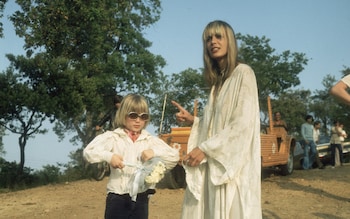 “They sheltered me as best they could, especially my mother”: Marlon and Pallenberg Photo: Hulton Archive/Getty Images
“They sheltered me as best they could, especially my mother”: Marlon and Pallenberg Photo: Hulton Archive/Getty Images
Deeply troubled by his death, Pallenberg began to see Jones as her baby. “She was absolutely horrified by Brian's death, and Anita would have been very good at believing that,” Marlon says. “I don’t feel it at all. But I had blond hair, which scared everyone.”
Marlon describes the first few years of his life, between touring with the Stones and constantly moving, not least to avoid media attention and various authorities as «chaotic».
“We moved around a lot, but if that’s all you know, that’s all you know,” he says. They were living a secluded existence in a small town in Switzerland when his sister Angela was born in 1972. In 1976, the second son Tara was born, but died as a child. The following year, in Toronto, Richards was arrested for heroin possession and given a suspended sentence after a court found that he had not imported the drugs into the country but had bought them from Canada.
Richards and Pallenberg both went to prison. rehabilitation. But while he was eventually able to wean himself off the drug, she was not. Banished from the Stones circle as a bad influence, she was settled in a house in a rural village in upstate New York. Marlon was eight, and for the first time in his life he was able to go to school and not go on tour — “thank God.”
Deprived of her passport, dependent on benefits from the Stones organization and living “like an animal in a cage,” Pallenberg fell to pieces, her weight rose to 13th place, her appearance ruined by alcohol and drugs.< /p>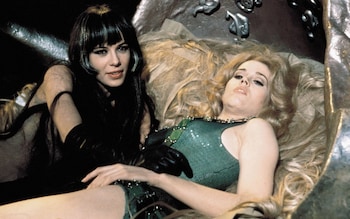 Anita Pallenberg and Jane Fonda in the film «Barbarella» Photo: Alamy
Anita Pallenberg and Jane Fonda in the film «Barbarella» Photo: Alamy
She became friends with a 17-year-old neighbor named Scott Cantrell. On July 20, 1979, Marlon, home from school, was watching a television program about the 1969 moon landing and eating a sandwich when he heard a gunshot from above, followed by a scream. His mother appeared, covered in blood and screaming that Cantrell had shot himself. They were lying in bed watching The Deer Hunter when it turned out that Cantrell, imitating a scene from the film, shot himself while playing Russian roulette.
“The child was worried. She shouldn’t have been with him at all,” Marlon recalls. “They were lying in bed when it happened and were probably both high. Anita was unable to do anything but sob in the corner. So I went to check.”
Showing amazing presence of mind, Marlon removed all traces of drug use before the police arrived. He was 10 years old. “Well, yes, I was taught this, otherwise my parents would go to prison. A similar thing happened in Toronto when they were arrested. There was a knock on the door and there stood a man in a red suit and a large cowboy hat. I thought: “Oh, look, the linemen are here!” Obviously this wasn't a good idea. After that, I learned that you have to fight everything.”
In her memoirs, Pallenberg wrote that she “turned her back” when Cantrell shot himself. The death was ruled a suicide. “I didn’t feel anything,” she said later. “This is one of the miracles of drugs and alcohol.”
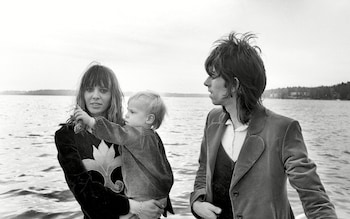 “They were irresponsible, but very loving parents”: Pallenberg, Marlon and Richards in 1970. Photo: Ilpo Musto/Shutterstock
“They were irresponsible, but very loving parents”: Pallenberg, Marlon and Richards in 1970. Photo: Ilpo Musto/Shutterstock
She and Marlon moved to a hotel in New York, where she met punk bands such as Television and the Dead Boys, then moved again to a mansion on Long Island, which in 1926 was used as a filming location for the first film, The Great Gatsby. «, before finally settling in London.
Marlon says of his upbringing: «They were irresponsible but very loving parents. I was always treated like an adult. They never sugarcoated anything, but they sheltered me as best they could, especially my mother.”
When he was seven or eight years old, he recalls, he took Spanish guitar lessons. His teacher believed he could progress to the next level, but Richards canceled the lessons. “He said, 'We don't need any more damn guitar players in the family; we need more accountants.” Marlon became a graphic designer.
“And I thank him for that. They both said don't get into the music business and don't do what we did. They deeply regretted the way it all happened in those days, and Keith still does. He got really upset about it all, and years ago I told him, don't worry, I'm here, I'm fine, and I'm not going to become a musician, so that's even better. «
In 1985, after several half-hearted attempts—Marlon estimates she was in and out of rehab about 10 times throughout her life—she finally got sober.
p> p>“She was a different person and definitely remorseful,” he says. “She was very hurt by what happened to us and felt she had to make amends. If anything, she was too motherly. I thought: I'm 16 years old, you don't need to put me to bed every night. And for the rest of her life she was like that.”
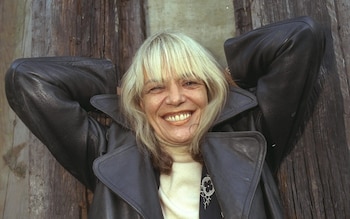 'Gangster Grandma': Pallenberg in her final years
'Gangster Grandma': Pallenberg in her final years
She completed a course in textiles and fashion at St Martin's School of Art, which was praised as «a triumph of style over substance abuse», farmed the property and became a doting grandmother, a «gangster grandma» to her five grandchildren.
She returned to modeling and appeared in six films, playing the devil in Absolutely Fabulous (Marianne Faithfull played God) and the queen's look-alike in Harmony Korine's Mister Lonely (2007), re-emerging as a style icon and a woman. a kind of talisman that has survived a more hedonistic era.
“Young people loved it because it was so different from today,” says Alexis Bloom, co-director of Catching Fire. “She was happy to behave shamefully. Talking about today's celebrities, we live in such a corporate, corporate culture that it is difficult to imagine the emergence of such a unique person as Anita. She was the complete opposite of that. The brand will absolutely run from Anita, not to her.»
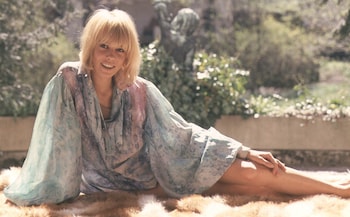 'She was unique': Pallenberg in his modeling years. Photo: Mangold
'She was unique': Pallenberg in his modeling years. Photo: Mangold
In 2007, after hip surgery that impaired her mobility and developing diabetes, she experienced what Marlon calls a “drinking relapse” and checked herself into rehab for the last time.
“We got through it.” . There was all this [family] therapy again, and it was very deep,” Marlon says. “She had to look Angela and me in the eye, apologize to both of us and write each of us a letter explaining how much she had let us down. It was almost too much. I felt very sorry for her during this process.”
He believes that she never intended to publish her autobiography during her lifetime. “She never wanted to rock the boat or be in the public eye again. But I think she wanted it all to happen posthumously in a sense. Knowing Anita, she would have burned the damn thing if she didn't want her to survive it. I really think she wanted her story to be told.»
Shortly before her death, she gave him all the home movies that appear in the film, with one instruction: «never give them to the Stones.» .
Catching Fire: The Anita Pallenberg Story in cinemas May 17























































Свежие комментарии